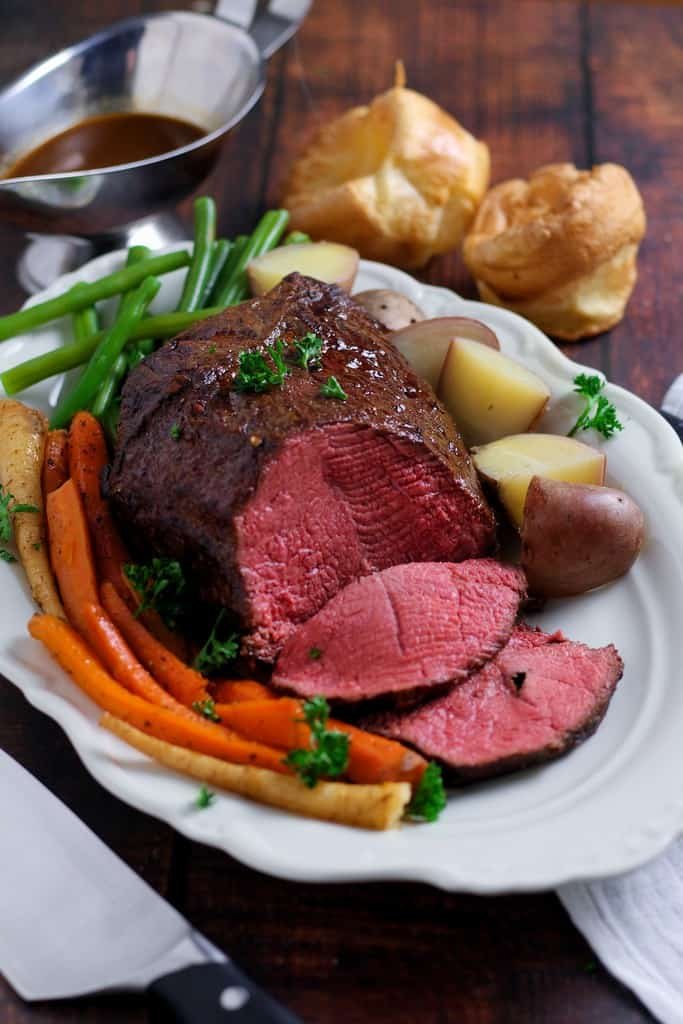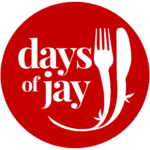
Slow Roast Beef
by Jay Wadams

Perfectly tender, rosy roast beef is easier than you think! Slow Roast Beef where the beef is seared before roasting at a very low temperature produces juicy, delicious beef every time.
Ingredients
- 1.2 kg 2.5 lb. beef roast (see notes)
- 2 Tbsp vegetable oil
- 1 Tbsp butter
- 1 Tbsp dijon mustard
- 2 tsp ground sweet paprika powder
- sea salt and black pepper
for the gravy:
- 1 Tbsp butter
- 1 medium onion sliced
- 1 stick celery roughly chopped
- 1 clove garlic halved
- 1 Tbsp tomato paste
- 1 Tbsp plain or all-purpose flour
- 125 ml full-bodied red wine
- 500 ml beef stock or bouillon
for the Yorkshire puddings:
- 4 Tbsp plain or all purpose flour
- ¼ tsp sea salt
- 4 Tbsp milk
- 4 Tbsp water
- 1 egg
- 2 tsp neutral oil or duck fat
Scan the QR Code to view the online recipe with detailed instructions, photos, hints, tips and more at daysofjay.com

Instructions
- IMPORTANT NOTE: Take the beef out of the refrigerator at least one hour before you want to start cooking.
- PREPARE: Heat the oven to 80°C / 175°F and place a roasting dish large enough to hold the beef on the middle rack. Rinse the beef and dry well with paper towel.1.2 kg 2.5 lb. beef roast (see notes)
- SEAR THE BEEF: Heat 1 tablespoon of the oil and the butter in a frying pan over a high heat. When the butter is hot and sizzling, brown the beef well on all sides. It’s important to get plenty of colour on the beef at this point as the slow cooking later will not colour the beef at all. It should take around 10 minutes in total.2 Tbsp vegetable oil, 1 Tbsp butter
- MAKE THE GLAZE: Meanwhile, whisk together the remaining oil, mustard and paprika.1 Tbsp dijon mustard, 2 tsp ground sweet paprika powder
- ROAST THE BEEF: When the beef is well browned on all sides, remove from the heat. Season generously with salt and pepper, then brush all over with the mustard mixture. Place in the preheated roasting dish, insert a meat thermometer into the thickest part of the meat and roast in the oven for 2.5-3 hours until the thermometer reads or 60-62°C (140-144°F).sea salt and black pepper
- MAKE THE GRAVY: To make the gravy, heat the butter in the pan that you browned the beef in. Cook the onion, celery and garlic over a medium heat, stirring until softened, around 10 minutes. Stir through the tomato paste and flour, cook for a further two minutes, then pour in the wine.1 Tbsp butter, 1 medium onion, 1 stick celery, 1 clove garlic, 1 Tbsp tomato paste, 1 Tbsp plain or all-purpose flour, 125 ml full-bodied red wine
- THICKEN THE GRAVY: Use a wooden spatula or spoon to scrape up all the browned on flavour on the bottom of the pan, then stir in the beef stock. Simmer until thickened, season to taste with salt and pepper, then strain into a clean saucepan and keep warm.500 ml beef stock or bouillon
- REST THE BEEF: When the beef is cooked, remove from the oven, cover with tinfoil and a tea towel and rest for 10-15 minutes before slicing and serving.
- MAKE YORKSHIRE PUDDINGS: To make the Yorkshire puddings, whisk together the flour and sea salt in a small bowl or jug. In a separate bowl whisk together the milk, water and egg, then stir the egg mixture into the flour until completely combined. Set aside for at least half an hour.4 Tbsp plain or all purpose flour, ¼ tsp sea salt, 4 Tbsp milk, 4 Tbsp water, 1 egg
- COOK YORKSHIRE PUDDINGS: After the meat is out of the oven, turn the heat right up to 230°C / 450°F. Divide the oil or fat between 4 muffin tins and heat in the oven until smoking. When the fat is hot, quickly divide the batter between the tins. Return to the oven and cook without opening the oven door for 15 minutes until puffed and golden brown.2 tsp neutral oil or duck fat
- SLICE AND SERVE: Serve the roast with gravy and Yorkshire puddings, I like to serve mine with honey glazed carrots and green beans.
Notes
- It is crucial that you take the meat out of the refrigerator at least one hour before you start to cook. This not only allows the meat to cook evenly through in the oven, but it will drastically reduce the amount of time it takes for the meat to reach the correct core temperature.
- The type of beef roast you use is really up to what is available. Silverside, topside, rump, sirloin and fore rib are all good options.
- In the US you might see cuts like Rib, short loin and round.
Nutrition
Serving: 1 portion | Calories: 674kcal | Carbohydrates: 14g | Protein: 73g | Fat: 32g | Saturated Fat: 11g | Polyunsaturated Fat: 6g | Monounsaturated Fat: 11g | Trans Fat: 0.3g | Cholesterol: 244mg | Sodium: 719mg | Potassium: 1464mg | Fiber: 1g | Sugar: 4g | Vitamin A: 372IU | Vitamin C: 3mg | Calcium: 114mg | Iron: 8mg